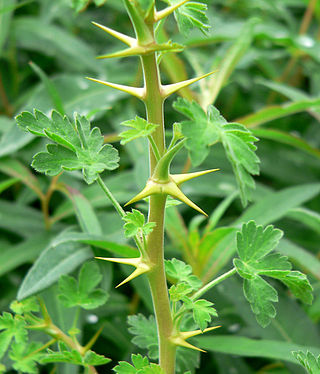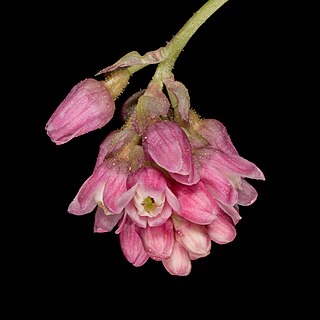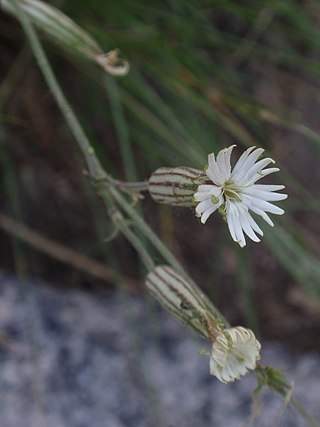
Ribes triste, known as the northern redcurrant, swamp redcurrant, or wild redcurrant, is an Asian and North American shrub in the gooseberry family. It is widespread across Canada and the northern United States, as well as in eastern Asia.

The redcurrant or red currant is a member of the genus Ribes in the gooseberry family. It is native to western Europe. The species is widely cultivated and has escaped into the wild in many regions.

Ribes malvaceum, the chaparral currant, is a member of the Grossulariaceae. It is native to California and northern Baja California, where it occurs from sea level to 1,500 metres (4,900 ft), in chaparral, foothill oak woodland, and closed-cone pine forest habitats.

Ribes speciosum is a species of flowering plant in the family Grossulariaceae, which includes the edible currants and gooseberries. It is a spiny deciduous shrub with spring-flowering, elongate red flowers that resemble fuchsias, though it is not closely related. Its common name is fuchsia-flowered gooseberry. It is native to central and southern California and Baja California, where it grows in the scrub and chaparral of the coastal mountain ranges.
Ribes amarum is a species of currant known by the common name bitter gooseberry. It is endemic to California, where it is known from mountains, foothills, and canyons. Its habitat includes Chaparral.
Ribes binominatum is a species of currant known by the common names trailing gooseberry and ground gooseberry.

Ribes californicum, with the common name hillside gooseberry, is a North American species of currant. It is endemic to California, where it can be found throughout many of the California Coast, Transverse, and Peninsular Ranges in local habitat types such as chaparral and woodlands.

Ribes canthariforme is a rare species of currant commonly known as the Moreno currant. It is characterized by pink to red flowers, a dense inflorescence, and a lack of nodal spines. A little-known endemic to the mountains of San Diego County, it is usually found growing the shade of massive boulders in the chaparral. Although the rarity and small numbers of this plant is a conservation concern, it is usually found in remote areas and is well hidden enough to be safe from most threats.

}}

Ribes indecorum is a species of currant known by the common names white-flowered currant and white chaparral currant. It is native to the southern California Coast Ranges, Transverse Ranges, and Peninsular Ranges, from around Santa Barbara County in California south into northern Baja California.
Ribes lasianthum is a species of currant known by the common names alpine gooseberry and woolly-flowered gooseberry. It is native to California, where it can be found in the San Gabriel Mountains and the Sierra Nevada, its distribution extending just into Nevada.
Ribes marshallii is a North American species of currant known by the common names Hupa gooseberry and Marshall's gooseberry. It is endemic to the Klamath Mountains of southern Oregon and northern California.

Ribes montigenum is a species of currant known by the common names mountain gooseberry, alpine prickly currant, western prickly gooseberry, and gooseberry currant. It is native to western North America from Washington south to California and east as far as the Rocky Mountains, where it grows in high mountain habitat types in subalpine and alpine climates, such as forests and talus. It is a spreading shrub growing up to 1.5 meters tall, the branching stems covered in prickles and hairs and bearing 1 to 5 sharp spines at intervals.

Ribes nevadense is a species of currant known by the common names Sierra currant and mountain pink currant.

Ribes quercetorum is a species of currant known by the common names rock gooseberry, oak gooseberry and oakwoods gooseberry. It is native to the mountains and hills of California from the San Francisco Bay Area south into Baja California and east into Arizona.

Ribes sericeum is a species of currant known by the common name Lucia gooseberry, or Santa Lucia gooseberry; its Latin epithet of sericeum means "of silk". It is endemic to California, where it is known only from the Santa Lucia Mountains along the Central Coast and an additional isolated population in Santa Barbara County.
Ribes victoris is an uncommon North American species of currant known by the common name Victor's gooseberry. It is endemic to California, where it grows in the chaparral and woods of canyons in the San Francisco Bay Area and counties to the north, as far as Humboldt County.

Ribes viscosissimum, also known as sticky currant, is a species of eudicot in the family Grossulariaceae. The species is native to North America. Pacific Northwest, Columbia Plateau, Great Plains, Great Basin, and southwest regions of western North America are native to this plant.

Acleisanthes nevadensis is a species of flowering plant in the four o'clock family known by the common names desert moonpod and desert wing-fruit. It is native to a section of the southwestern United States encompassing southern Nevada and adjacent corners of Utah and Arizona. One occurrence has been observed in eastern California. The plant grows in desert habitat such as scrub and rocky washes. This herb produces several spreading stems up to about 30 centimeters in maximum length, sometimes from a woody base. The stems are covered in many leaves with fleshy oval or rounded blades up to 3 centimeters long which are borne on petioles. The herbage of the plant is coated in thick, wide, white, furry hairs, interspersed with shorter, flat hairs. Some hairs are glandular. Flowers occur in leaf axils. Each is a trumpet-shaped bloom with a narrow, tubular green throat up to 4 centimeters long and a round white corolla face about a centimeter wide, sometimes tinged yellow or greenish. There are five long, protruding stamens and a long style tipped with a spherical stigma. The fruit is a ribbed, hairy body with five broad, white wings.

Silene bernardina is a species of flowering plant in the family Caryophyllaceae known by the common name Palmer's catchfly.
















